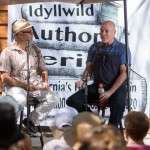As the autumn season progresses here on the Hill and elsewhere, more opportunities arise to hear live music performances and as a rule tend to improve with the advent of cooler weather, at least from the viewpoint of this reviewer.
The latest of these occasions took place last week and was as equally rewarding as the previously reviewed orchestral concert — though in a somewhat different context. The Taiwanese-born and Hungarian-adopted pianist Hsin-Ni Liu came to the Idyllwild Arts Academy following her pedagogic efforts in a master class with as concentrated a program of piano music as readily explicated. Though from the observed attendance (generally confined to the left-hand side of the hall, with an abundance of empty chairs elsewhere), the concentration turned upon the spectators’ required observance of an original effort on Liu’s part to impart both works on the program with an equally requisite emphasis on piano technique, in view of the respective inherent difficulties involved.
Taking the theme from Handel’s suite in B-flat major (an “air” within five variations), Brahms expanded on both the original theme and the elder composer’s variations (a total of 25 in all), plus a concluding fugal variation which confirmed Brahms’ intention to put himself in the forefront of mid-19th century musical thinking, as well as to solidify his pianistic position as a worthy enough virtuoso of the instrument.
Liu’s interpretation certainly enforced her own virtuosity from the beginning to the end of the work. Her traversal of the styles in each variation was seemingly effortless, transforming each group into an exposition of the composer’s wishes. Gratifying as this was in the long run, what was particularly interesting in the performance Liu’s concentrated posture over the keyboard, as if to emphasize the various depths of the piece as it broadened toward its fugal conclusion.
A short interlude followed before the presentation of Mussorgsky familiar suite, and this reviewer is ever grateful for any performance of the original piano version, intended originally as a memorial for the artist Victor Hartmann, but subjected to the criticism of being “unpianistic.” Consequently, it can be rearranged for various instrumental ensembles, including full orchestra.
Liu’s own traversal of the suite reflected her individual styles in certain portions, but with an overall grasp of the actual memorial tribute involved. The “Catacombs” section went as solemnly as ever with the succeeding “Promenade” variation equally majestic.
The lead into the final “Great Gate of Kiev” was forcefully thrilling as a conclusion to a magnificent display of tension and release of sonic vigor with a well-tuned and responsive Steinway instrument. This listener will be expecting more from her efforts, on behalf of live music in particular, as well as a potential return for major pianistic adventures in the future.
In memory of another music appreciator, the late Jan Jaspers-Fayer.










